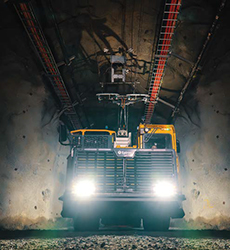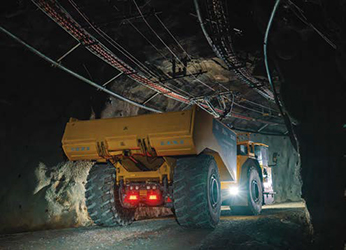
Boliden, Epiroc and ABB have taken the mining industry a step close to the
all-electric mine of the future. (Photo: Boliden
Bringing the World’s First Battery-electric
Trolley Haulage System to Life
We visited Boliden’s Kristineberg mine in Sweden to see its new
battery-electric trolley test track in action, and learn about the collaboration
behind the breakthrough innovation
By Carly Leonida, European Editor

E&MJ joined the three partners in August for a tour of the test facility and to gain more insight into the project. “We are united in our commitment to sustainability,” Jérôme Cloué, vice president of electrification at Epiroc, said of the trio: “Our collaboration is essential in pushing the boundaries of what’s possible in electrification, and that’s exactly what we’ve done through this project.”
Designing a Safe,
Productive System
The project began in 2021 with the aim
of finding a zero-emission, wheel-based
haulage solution for the Rävliden mine
— a satellite orebody and extension of
the Kristineberg mine located in the Boliden
Area — which will, eventually, be
a fully electric operation.
At the time, no battery-electric trolley
trucks or systems were commercially
available (although there is a Kiruna
truck installation running at a mine in
Canada), and the mine faced the additional
challenges of experiencing high
humidity and dust levels, and highly
acidic (pH 2) water ingress.
To make their vision a reality, the
teams worked together to design and
build the necessary systems for both
the truck and the mine, as well as define
new vehicle interfaces and the necessary
standards.
Similar to an open-pit trolley installation, the system powers the battery- electric mine truck when travelling fully loaded up-ramp and enables battery regeneration during drifting. ABB’s eMine Grid-to-Wheel solution provided the backbone for the electrical infrastructure, which includes on-truck hardware, such as the pantograph, motors and inverters, as well as catenary lines, rectifiers and substations for energy delivery in the mine. The substation for the test track was pre-manufactured and shipped to the site in a split container for easy transportation underground. It was configured with a 12-kV OHL switchgear and 1,500 volts-DC capable of powering a track up to 1,700-m in length. A 1.5-mega- Watt (MW) controlled rectifier was also selected, along with two 1.8-MW diode rectifiers, auxiliaries and interfaces.
The tunnels in which the vehicle operates are multipurpose, accommodating light vehicle traffic as well as haulage, and the cramped conditions meant that electrical and environmental safety were a big focus from day one. Insulation of the electrical components was key, as the dust that Kristineberg generates is conductive due to the presence of microscopic copper particles. ABB’s Strategic Account Manager for Boliden, Lars Brännstrom, explained that multiple control layers have been built into the system to ensure its safety and that, despite running it under the toughest conditions during testing e.g., 100% humidity, there were no insulation issues.
He added that regardless of whether a trolley system is designed for openpit or underground use, it’s vital that miners and their suppliers work together to fine tune system performance and understand the wider impacts of the trolley system on the operation. For example, he explained that during testing, road maintenance was found to be crucial in smoothing the truck ride and improving contact between the pantograph and the overhead lines.
Creating the MT42 SG
Trolley Truck
For the truck, Epiroc adapted its proven
MT42 S battery-electric model (42-metric-
ton haulage capacity), equipping it
with an ABB DC/DC converter, HES880
inverters and AMXE motors. The new
prototype, dubbed the MT42 SG Trolley,
has a 40% smaller battery than its
predecessor with a new heating and
cooling system, a pantograph (which
has a similar design to that used on
road trucks) plus control system, and
voltage converters.

Anders Lindkvist, product manager for large minetrucks at Epiroc, who spearheaded the new truck design said that thanks to the lower wear rate, the battery on the MT42 SG Trolley is expected to last around 50% longer than that in the MT42 S — at least a full truck lifetime, or approximately 20,000 operating hours, depending upon the application. Currently, the new truck costs around 30% more than its predecessor, but Epiroc is working to lower this. The teams emphasized that it’s still early days for the system, but benefits thus far include an 80% reduction in heat compared to a diesel truck. CO2 emissions are reduced by 70% depending on the electrical source, and operating noise is greatly reduced.
Ventilation requirements are also lower compared to both diesel and battery-electric trucks that use static charging. For example, three MT42 S trucks require around 400-kW of ventilation per truck, plus 300-kW for ground ventilation — a total of 1,500-kW. In contrast, the MT42 SG Trolley doesn’t require any truck ventilation, so only 300-kW of ground ventilation is needed. In terms of production, the system does not need to stop for refueling, charging or battery swapping. When combined with automation, it can run 24/7, boosting simulated production (tons per hour) by 50% compared to a diesel fleet and 25% compared to a battery-electric fleet that uses static charging. Most of the moving parts (90%) have been eliminated from the truck design which significantly reduces its maintenance requirements, and the electric drivetrain provides a higher travel speed on ramps than both diesel and battery-electric trucks.
The Next Steps
During development, extensive simulations
were used to optimize the test setup
and predict the final requirements of
Rävliden’s haulage system. This allowed
Epiroc and ABB to help Boliden calculate
its optimal fleet size and understand how
best to build redundancy into the system.
Following a year of testing, Boliden
has given the greenlight to implement a
full scale, 5-km long autonomous electric trolley system at Rävliden, and has
placed an order for four Minetruck MT42
SG Trolley trucks from Epiroc, the production
of which has already begun.
Going forward, the ABB-Epiroc designed trolley system is now commercially available for other operators to purchase, a number of whom were onsite to see the test track for themselves when E&MJ visited. The system is vendor agnostic which means that in the future, it could be used with compatible battery-powered vehicles from other manufacturers, although it can be rolled out immediately with an MT42 SG Trolley fleet.
The system is best suited to mines with long, straight haul ramps (although curves can be accommodated too), high productivity requirements and a long mine life (5+ years depending upon production). The drifts at the Kristineberg test site measure 6-m wide and 6-m high, but the system can be adapted for smaller tunnels too. Both brownfield and greenfield installations can be accommodated, although the teams pointed out that, at a greenfield application like Rävliden, the system would be easier to optimize.

Franck Boudreault, Underground Application Expert Electrification at Epiroc, added: “In the future, another piece of kit that could benefit from dynamic charging capabilities are graders. These vehicles spend a lot of time on the ramp and consume a lot of energy, so they could be the next followers.”
Go Together, Go Faster
Ultimately this project demonstrates
the value, speed and ingenuity that collaboration
can bring to mine electrification
projects: the future is, quite literally,
brighter for everyone, if companies
can find ways to work together.
“No company can solve the challenge of climate change alone,” Ratna- Kanth Dittakavi, global eMine sales manager at ABB, summarized. “Collaborations not only accelerate our progress towards decarbonization, but also bring forward solutions, ideas and knowledge that companies might not have considered otherwise.
“It’s important that we all work together to define and create open, interoperable, agnostic solutions and standards, so that we can meet the needs of the energy transition. This project is an example of what we can achieve if we work together.”